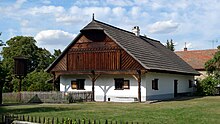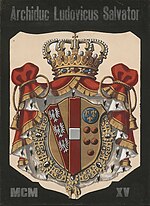Archduke Ludwig Salvator of Austria
- View a machine-translated version of the German article.
- Machine translation, like DeepL or Google Translate, is a useful starting point for translations, but translators must revise errors as necessary and confirm that the translation is accurate, rather than simply copy-pasting machine-translated text into the English Wikipedia.
- Consider adding a topic to this template: there are already 9,121 articles in the main category, and specifying
|topic=will aid in categorization. - Do not translate text that appears unreliable or low-quality. If possible, verify the text with references provided in the foreign-language article.
- You must provide copyright attribution in the edit summary accompanying your translation by providing an interlanguage link to the source of your translation. A model attribution edit summary is
Content in this edit is translated from the existing German Wikipedia article at [[:de:Ludwig Salvator von Österreich-Toskana]]; see its history for attribution. - You may also add the template
{{Translated|de|Ludwig Salvator von Österreich-Toskana}}to the talk page. - For more guidance, see Wikipedia:Translation.
| Archduke Ludwig Salvator | |||||
|---|---|---|---|---|---|
| Count of Neuendorf | |||||
 | |||||
| Born | (1847-08-04)4 August 1847 Florence, Tuscany | ||||
| Died | 12 October 1915(1915-10-12) (aged 68) Schloss Brandeis, Brandýs nad Labem-Stará Boleslav, Austria-Hungary | ||||
| |||||
| House | Habsburg-Lorraine | ||||
| Father | Leopold II, Grand Duke of Tuscany | ||||
| Mother | Princess Maria Antonia of the Two Sicilies | ||||
Archduke Ludwig Salvator of Austria (Italian: Luigi Salvatore Maria Giuseppe Giovanni Battista Dominico Raineri Ferdinando Carlo Zenobio Antonino, German: Ludwig Salvator Maria Joseph Johann Baptist Dominicus Rainerius Ferdinand Carl Zenobius Antonin) (Florence, 4 August 1847 – Schloss Brandeis, Brandýs nad Labem-Stará Boleslav, Austria-Hungary, 12 October 1915), was an Austrian archduke of the House of Habsburg who became known as a champion for Majorca's wildlife, in an era when the term "conservation" was not highly regarded.[citation needed] The Balearic Islands commemorated the centenary of the death of Archduke Ludwig Salvator during 2015.
Ludwig Salvator settled on Majorca, buying up unimproved areas of land in order to preserve and enjoy them. His main residence of Son Marroig, near the village of Deià, is now a museum. Much of what was his property now belongs to the American actor Michael Douglas, notably the Moorish style palace 'S'Estaca' that Ludwig converted from a ruined old manor house.
About 1895, at Přerov nad Labem, Bohemia, he founded the first open-air museum in Central and Eastern Europe.
Works

He wrote a book on insects at the age of 22 and also the nine-volume book Die Balearen (The Balearic Islands). Having visited Los Angeles, California, in the winter of 1876, he published in 1878 an account of his visit, Los Angeles in Südcalifornien. Eine Blume aus dem goldenen Lande.
Background
He was the second cousin of Emperor Franz Joseph, of the ruling House of Habsburg-Lorraine, the fourth son of Leopold II, Grand Duke of Tuscany. Ludwig went to Majorca under his title of Count of Neuendorf, arriving in 1867. Falling in love with the clear air, water and dazzling blue skies of Majorca it was to become his base and home for the remainder of his life.

He explored on his steam-yacht the Nixe. He was known for his extreme love of animals and nature.
Archduke Ludwig Salvator never married. When he was young, he fell in love with a cousin, Archduchess Mathilde, the daughter of the Duke of Teschen. Ludwig wanted to marry her, but she was promised to Prince Umberto of Savoy. On June 6, 1867, Mathilde, then only 18, was getting dressed to attend the theatre. She enjoyed smoking cigarettes, but when her father, who abhorred smoking appeared, she tried to hide the cigarette behind her. Her dress caught fire, and she died in front of her family, sustaining second and third-degree burns. Relationships with women included Catalina Homar. She convinced Ludwig to let her visit Jerusalem and it is believed that it was there that she contracted the leprosy that took her life in 1905.
He fathered numerous illegitimate children.[1]
When the First World War broke out, in 1914, the Emperor of Austria ordered Ludwig Salvator to leave Majorca, and in 1915, he died at the family castle of Brandeis-Altbunzlau, in Bohemia. He was buried in Vienna. In his will he designated Antonio Vives y Colom –his personal secretary, collaborator and trusted man, whom he met in Mallorca, and who accompanied him from 1872 until his death– and his children as his heirs.
Researcher and chronicler of the Mediterranean sea
It was of great importance to Ludwig Salvator to stimulate public interest in landscapes, which he thought were unjustifiably little known and rarely visited. His attention focused less on classical cultural centers, but on small, undiscovered regions, like Collection of costumes and type images of Serbs in the region on the Adriatic Sea between Rijeka and northern Albania by 45 plates with color lithographs based on watercolors Die Serben an der Adria (1870–1878), including the islands of Paxos and Antipaxos, Ithaca, Lefkada and Zakynthos in the Ionian Sea and the Aeolian Islands in the north of Sicily, the islands of Giglio, Ustica and Alboran, and especially the then largely unknown Balearic Islands of Mallorca, Menorca, Eivissa (Ibiza) and Formentera. In 1869, there appeared the first volume, dedicated to Emperor Franz Joseph, of his massive Die Balearen. In Wort und Bild geschildert (The Balearic Islands, portrayed in words and images); the total work encompasses seven separate volumes extending to approximately 6000 pages. For their first two volumes he was awarded the gold medal of the Paris World Exhibition of 1878. This monograph contains descriptions of animals, plants, meteorology, history, folklore, architecture, landscape descriptions and also detailed descriptions of the population, their customs, songs and poems. In 1897 there was published a two-volume popular edition with the same title that contained the main illustrations and texts. It is located on loan from the Österreichische Geographische Gesellschaft (Austrian Geographical Society) in the National Archives of Austria.[2]
Honours and arms
| Styles of Archduke Ludwig Salvator | |
|---|---|
 | |
| Reference style | His Imperial and Royal Highness |
| Spoken style | Your Imperial and Royal Highness |
 Austria-Hungary:[3]
Austria-Hungary:[3] - Knight of the Golden Fleece
- Military Jubilee Cross
 Grand Duchy of Tuscany: Grand Cross of St. Joseph[3]
Grand Duchy of Tuscany: Grand Cross of St. Joseph[3] Spain: Grand Cross of the Order of Charles III[3]
Spain: Grand Cross of the Order of Charles III[3]
References
- ^ Koenig, Marlene Eilers (14 October 2015). "Royal Musings: Death of Archduke Ludwig Salvator".
- ^ Bibliothek Archived February 3, 2015, at the Wayback Machine consulted on 26 September 2010
- ^ a b c Hof- und Staatshandbuch der Österreichisch-Ungarischen Monarchie (1915), Genealogy p. 6
- Hammer, Ute. Oliver. Toniner and Schauhoff, Frank. 'Majorca: Culture and Life' Konemann Publishing
External links
 Media related to Archduke Ludwig Salvator of Austria at Wikimedia Commons
Media related to Archduke Ludwig Salvator of Austria at Wikimedia Commons
- Menorca yesterday and today. Discovering Menorca with original engraving taken from Die Balearen. Archduke Ludwig Salvator of Austria.
- www.ludwig-salvator.com/
- v
- t
- e
- Joseph I
- Leopold Joseph
- Charles III
- Joseph IIT
- Charles JosephT
- Leopold VIIT
- FerdinandT
- Maximilian Franz, Archbishop-Elector of CologneT
- Emperor Ferdinand I
- Joseph Franz
- Franz Karl
- Leopold II, Grand Duke of TuscanyT
- Albrecht
- Karl Ferdinand
- Frederick Ferdinand
- Wilhelm Franz
- Stephen
- Joseph Karl
- Leopold Ludwig
- Ernest
- Sigismund
- Rainer Ferdinand
- Heinrich Anton
- Francis V, Duke of ModenaM
- Ferdinand Karl ViktorM
| |
| Habsburg Tuscany |
|
|---|---|
| Palatines of Hungary | |
| Descent of Charles I |
|
|---|---|
| Tuscany | |
| Palatines |
| Charles |
|---|
| Charles |
|---|
- S: also an infante of Spain
- P: also an infante of Portugal
- T: also a prince of Tuscany
- M: also a prince of Modena
- B: also a prince of Belgium













